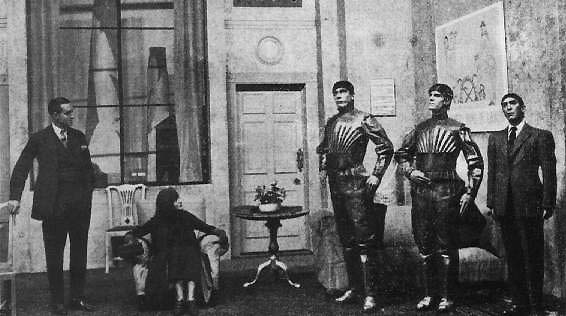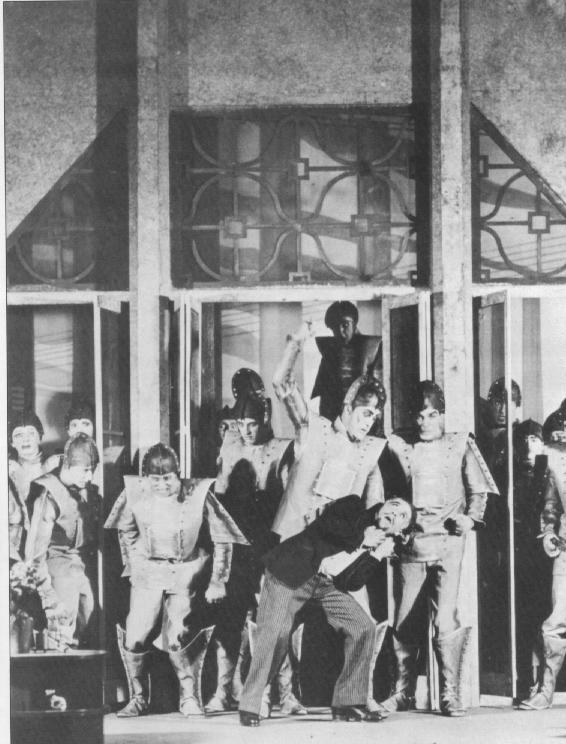
While the concept of artificial life finds its antecedents all the way back to antiquity, the first application of the term "robot" occurred in a play written by Karel Capek entitled R.U.R. The term is derived from the Czech word "robota," which means compulsory labor.
Capek published R.U.R. or Rossum's Universal Robots in 1921. It is the first of his five plays carrying a utopian theme. The published translation from Czech into English came out two years later. Its first performance in New York was at the Garrick Theatre on October 9, 1922. It was the first production of the fifth season of The Theatre Guild.
The play in the original occurs in three acts. It takes place at a factory complex on an island whose national allegiance and location are unspecified. The human characters of the play are as follows:
The Robot characters are as follows:

ACT I
The first act takes place in the Central Office, where Helena Glory first meets Harry Domin. She is the daughter of President Glory, who is presumably the leader of the unnamed nation to which the island factory belongs. Apparently she has arrived as a representative for President Glory and with that clout wishes for a tour of the factory. Domin accepts her credentials, but before giving a tour, he first recounts for her the origins of the factory and its product, the Robots (referred to within the text with a capital "R").
Domin explains that in 1920, Rossum, a great physiologist, traveled to a distant island in order to study the ocean fauna. He attempted to find the chemical synthetic equivalent of protoplasm. In 1932, he discovered a substance which functions like living matter but with a different chemical composition. During the many years to follow, the scientist engaged in two unsuccessful attempts to create sustainable artificial life. First, he tried to make a dog which resulted in a malformed creature that lived for only a few days. For ten years after that, he worked his way towards constructing an artificial human being, but that entity lived for a mere three days.
Young Rossum, the scientist's son, eventually came along to bring an engineer's perspective. He sought to incorporate efficiency into the process of making an artificial human being. On a physical level, this entailed a simplifying the design of the organs. On a metaphysical level, this entailed excluding the capacity to experience pleasure and engage in recreation. He viewed such things as "time-wasters" for an artificial being designed merely for labor. Ultimately, his work lead to the successful manufacturing of Robots which Domin now oversees.
After Domin finishes the story, Helena meets two of the Robots and then the rest of the managerial staff. Through a series of misunderstandings and erroneous assumptions, Helena unwittingly reveals her true purpose for coming to the factory. She has come on behalf of an organization called the Humanity League whose goal is to seek fair and equitable treatment of the Robots.
However, the managerial staff is not at all alarmed by her revelation. They explain to her that her intention to liberate the Robots is entirely futile, since such an endeavor would entail appealing to human sensibilities that they claim the Robots simply do not have. Domin waxes on about the benefits of using the Robots as a source of cheap and efficient labor, which would free humanity from the drudgery of manual labor thus allowing individuals to pursue goals of personal improvement. Only Alquist remains somewhat skeptical, believing that there is "some kind of virtue in toil and weariness." Towards the end of Act I, Domin unexpectedly confesses his love for Helena and asks her to marry him. She implicitly accepts his proposal by acceding to his kiss.
ACT II
By the second act, ten years have passed. The scene is Helena's drawing room. Domin is doing his best to shelter his wife Helena from the problems that have ensued from using the Robots. But little by little, she discovers that serious problems are developing not only within the factory itself, but throughout the rest of the world. Some of the Robots on hand are acting strangely, almost belligerently at times.
Helena learns from Dr. Gall that he has been experimenting by developing different Robots that are "more sensitive than others." Radius the Robot is a product of this difference. Through other sources, Helena also learns that worldwide birthrates have dropped to zero, presumably because extending the human population would be superfluous now that the Robot population provides the work force. Furthermore, Robots are now being employed as soldiers as well as laborers. In the resulting wars, the human fatalities have been extremely high. In her horror, she burns the only manuscripts that hold the secrets to building the Robots.
Even Domin and the managerial staff are not aware of the full extent of humanity's dire predicament, but by the end of Act II they learn that the Robots throughout the world have rallied together for the purpose of annihilating the human race, which has been judged inferior to Robots and therefore superfluous. The peril becomes immediate when they realize that the Robots of the factory itself have taken control of the island and now surround their building.
ACT III
Domin, Helena, and the rest of the staff are trapped in the building, but they manage to keep the Robots at bay by electrifying the bordering fence. They brainstorm for a plan to extricate themselves from the situation. They know that the Robots will need the Rossum's manuscripts in order to perpetuate themselves, so they decide to use it as a negotiating piece in exchange for their lives. However, Helena reveals that she has burned the manuscripts. In a desperate scramble to find other options, the electricity gives out. The Robots invade till the only person left alive is Alquist.

EPILOGUE
The Robots have taken over the entire world, however, by this point they realize that they do not know how to make more of their kind. Alquist is an old man now, kept alive by the Robots in their hope that he will re-discover the means to construct more Robots. He struggles to find a way, reasoning that if there are no humans left, there should at least exist "the shadow of man," meaning the Robots. But he is not a scientist, merely a builder, and is thus unable to derive the principles that give life to the Robots.
During the final moments of the play, Alquist witnesses unprecedented characteristics manifest themselves within Primus the Robot and Helena the Robotess, which indicate that they have fallen in love. He sees in them an evolution beyond the other Robots that brings them closer to being human. He acknowledges almost in the manner of a blessing their potential role as a new Adam and Eve for the World.
![]() Go to
Questions for Analysis on R.U.R.
Go to
Questions for Analysis on R.U.R.
![]() Move
back to the top of the page.
Move
back to the top of the page.